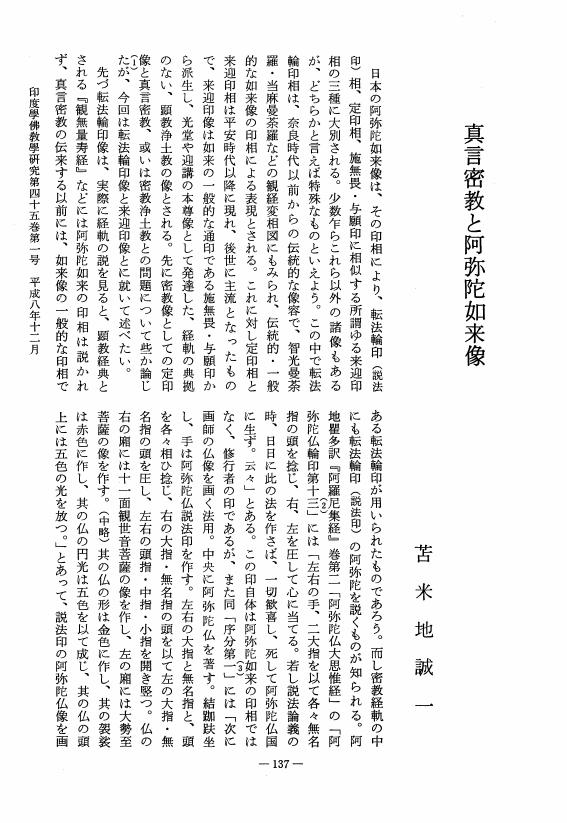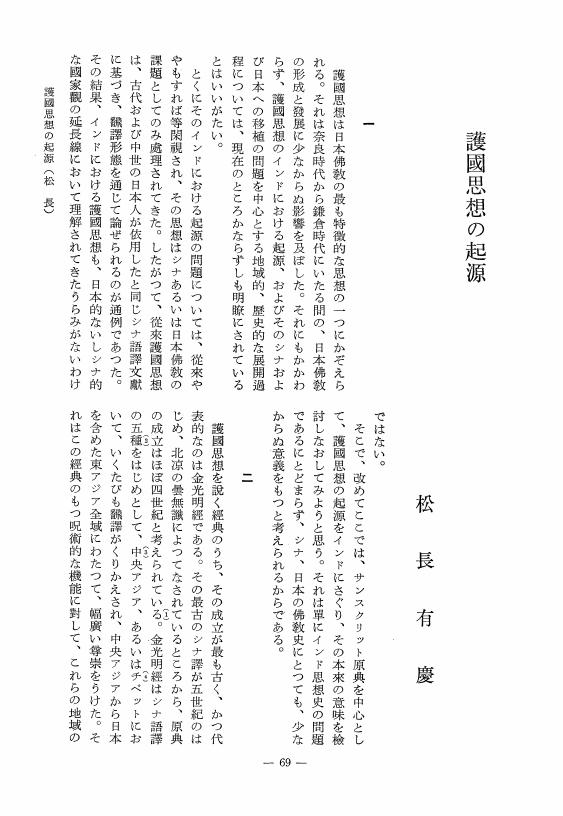1 0 0 0 OA 大夫坊覚明と『平家物語』
- 著者
- 根井 浄
- 出版者
- Japanese Association of Indian and Buddhist Studies
- 雑誌
- 印度學佛教學研究 (ISSN:00194344)
- 巻号頁・発行日
- vol.31, no.2, pp.668-671, 1983-03-25 (Released:2010-03-09)
1 0 0 0 OA 菩提流支訳出経論における如来蔵の概念
- 著者
- 織田 顕祐
- 出版者
- Japanese Association of Indian and Buddhist Studies
- 雑誌
- 印度學佛教學研究 (ISSN:00194344)
- 巻号頁・発行日
- vol.41, no.2, pp.572-579, 1993-03-25 (Released:2010-03-09)
1 0 0 0 OA 法華宗と三条実香についての一考察 -中世京都法華宗と公家の関係の一つの例として-
- 著者
- 坂輪 宣政
- 出版者
- Japanese Association of Indian and Buddhist Studies
- 雑誌
- 印度學佛教學研究 (ISSN:00194344)
- 巻号頁・発行日
- vol.51, no.2, pp.697-699, 2003-03-20 (Released:2010-03-09)
1 0 0 0 OA 真言密教と阿弥陀如来像
- 著者
- 苫米地 誠一
- 出版者
- Japanese Association of Indian and Buddhist Studies
- 雑誌
- 印度學佛教學研究 (ISSN:00194344)
- 巻号頁・発行日
- vol.45, no.1, pp.137-140, 1996-12-20 (Released:2010-03-09)
1 0 0 0 OA J. W. ドゥ ヨング著 オランダのインド學・佛教學
- 著者
- 湯山 明
- 出版者
- Japanese Association of Indian and Buddhist Studies
- 雑誌
- 印度學佛教學研究 (ISSN:00194344)
- 巻号頁・発行日
- vol.14, no.1, pp.382-359, 1965-12-25 (Released:2010-03-09)
1 0 0 0 OA 高句麗における仏塔の受容と展開について -文化的背景を中心に-
- 著者
- 金 春鎬
- 出版者
- Japanese Association of Indian and Buddhist Studies
- 雑誌
- 印度學佛教學研究 (ISSN:00194344)
- 巻号頁・発行日
- vol.54, no.1, pp.534-531,1288, 2005-12-20 (Released:2010-03-09)
When thinking of pagodas in Koguryo, the first question that comes to mind is where the first pagoda can be found. Also, the origin of the characteristics of Koguryo's pagodas is a problem. For example, what is the history of the one pagoda-three image hall pattern (一塔三金堂式) in the composition of Buddhist temple, and what the background of the the octagonal shape of the pagoda? In this paper I emphasize the fact that the cultural background of the characteristics of pagodas in Koguryo can be found in Koguryo's ancient tombs.
1 0 0 0 OA 浄意法師について -特に宇都宮氏と証空の関係から-
- 著者
- 野村 恒道
- 出版者
- Japanese Association of Indian and Buddhist Studies
- 雑誌
- 印度學佛教學研究 (ISSN:00194344)
- 巻号頁・発行日
- vol.30, no.1, pp.154-155, 1981-12-31 (Released:2010-03-09)
1 0 0 0 OA 世界の終末と最高神
- 著者
- 井上 信生
- 出版者
- Japanese Association of Indian and Buddhist Studies
- 雑誌
- 印度學佛教學研究 (ISSN:00194344)
- 巻号頁・発行日
- vol.45, no.1, pp.486-482, 1996-12-20 (Released:2010-03-09)
- 被引用文献数
- 1 1
1 0 0 0 OA 親鸞の肉食観-『浄肉文』を通して-
- 著者
- 吉田 宗男
- 出版者
- Japanese Association of Indian and Buddhist Studies
- 雑誌
- 印度學佛教學研究 (ISSN:00194344)
- 巻号頁・発行日
- vol.45, no.2, pp.577-580, 1997-03-20 (Released:2010-03-09)
1 0 0 0 OA 護國思想の起源
- 著者
- 松長 有慶
- 出版者
- Japanese Association of Indian and Buddhist Studies
- 雑誌
- 印度學佛教學研究 (ISSN:00194344)
- 巻号頁・発行日
- vol.15, no.1, pp.69-78, 1966-12-25 (Released:2010-03-09)
1 0 0 0 OA 聖徳太子における生死の問題
- 著者
- 武田 賢壽
- 出版者
- Japanese Association of Indian and Buddhist Studies
- 雑誌
- 印度學佛教學研究 (ISSN:00194344)
- 巻号頁・発行日
- vol.14, no.1, pp.233-237, 1965-12-25 (Released:2010-03-09)
1 0 0 0 OA ウルドゥー古典詩人の雅号に関する一考察
- 著者
- 鈴木 斌
- 出版者
- Japanese Association of Indian and Buddhist Studies
- 雑誌
- 印度學佛教學研究 (ISSN:00194344)
- 巻号頁・発行日
- vol.38, no.1, pp.336-341, 1989-12-20 (Released:2010-03-09)
- 参考文献数
- 1
1 0 0 0 泉福寺本『正法眼蔵聞書抄』の諸問題 -「坐禅儀聞書抄」を中心に-
- 著者
- 西尾 勝彦
- 出版者
- JAPANESE ASSOCIATION OF INDIAN AND BUDDHIST STUDIES
- 雑誌
- 印度學佛教學研究 (ISSN:00194344)
- 巻号頁・発行日
- vol.52, no.2, pp.545-548, 2004
- 著者
- 西尾 勝彦
- 出版者
- JAPANESE ASSOCIATION OF INDIAN AND BUDDHIST STUDIES
- 雑誌
- 印度學佛教學研究 (ISSN:00194344)
- 巻号頁・発行日
- vol.51, no.1, pp.179-181, 2002
- 著者
- 柏原 信行
- 出版者
- JAPANESE ASSOCIATION OF INDIAN AND BUDDHIST STUDIES
- 雑誌
- 印度學佛教學研究 (ISSN:00194344)
- 巻号頁・発行日
- vol.31, no.2, pp.884-881, 1983
1 0 0 0 OA Vasubandhu 研究ンート (1)
- 著者
- 松田 和信
- 出版者
- Japanese Association of Indian and Buddhist Studies
- 雑誌
- 印度學佛教學研究 (ISSN:00194344)
- 巻号頁・発行日
- vol.32, no.2, pp.1042-1039, 1984-03-25 (Released:2010-03-09)
1 0 0 0 OA 象徴的寓話に示されたイスラームによる「ヨーガ」の理解
- 著者
- 榊 和良
- 出版者
- Japanese Association of Indian and Buddhist Studies
- 雑誌
- 印度學佛教學研究 (ISSN:00194344)
- 巻号頁・発行日
- vol.58, no.3, pp.1139-1143, 2010-03-25 (Released:2017-09-01)
『アムリタクンダ』は,既に明らかにしたように,カーマルーパの女神をめぐるマントラを伴う祈願法と,『シヴァスヴァローダヤ』に代表されるナータ派文献にも含まれる呼吸を観察することによる占術を含むタントラ・ヨーガ文献である.13世紀末から14世紀中頃にアラビア語・ペルシア語に訳され,16世紀中頃にはインドのシャッターリー教団のスーフィーの手でイスラーム色を濃くした形でペルシア語で重訳され,中央アジアからトルコ,西アジアからマグリブ世界まで広く伝搬した理由は,寓意文学やその解釈学を発展させたイスラームの伝統を受け継いだ枠物語にある.それは,『トマス行伝』に含まれる「真珠の歌」やイフワーヌッサファー(純粋なる心をもった兄弟)と呼ばれる学者集団による『百科全書』に示された小宇宙観などの影響のもとに,中世イランの哲学者イブン・スィーナーの系譜を継いだスフラワルディーによる『愛の真実に関する論攷』に含まれる「愛」の語る物語を模している.異邦の地への旅を経ての故郷への帰還と「生命の水」による新たな生まれ変わりを核とした寓意的物語を枠として,大宇宙と小宇宙の相即性から説き起こし,「息の学」を媒介として,浄化法やチャクラへの瞑想法をとりこみつつ,本来の自己の認識による救済をめざすありかたが示される.人間の肉体をひとつの町として描き出す枠物語の示す象徴世界は『ゴーラク語録』にも共通性が見出されるが,『ゴーラクシャシャタカ』大本のペルシア語訳にも示されるように,ナータ派文献に示されるヨーガは,霊智による救済を獲得する手段としてスーフィー道と共通性をもつものと理解され,『アムリタクンダ』の翻訳者は,グノーシス的枠物語によって有資格者のためのイニシエーションとして視覚化して見せてくれたのである.
1 0 0 0 OA 明治維新後の社会状況と日蓮宗
- 著者
- 渡邊 寶陽
- 出版者
- Japanese Association of Indian and Buddhist Studies
- 雑誌
- 印度學佛教學研究 (ISSN:00194344)
- 巻号頁・発行日
- vol.49, no.2, pp.566-572, 2001-03-20 (Released:2010-03-09)
1 0 0 0 OA 『獅子座三十二話』グジャラート伝本へのジャータカの影響の痕跡
- 著者
- 松村 恒
- 出版者
- Japanese Association of Indian and Buddhist Studies
- 雑誌
- 印度學佛教學研究 (ISSN:00194344)
- 巻号頁・発行日
- vol.55, no.1, pp.287-280,1209, 2006-12-20 (Released:2010-03-09)
In this paper, the relationship between the Sanskrit versions and the later Gujarati offshoots of the Simhasanadvatrimsika is examined. Based on the comparison of Malayacandra's version and four Sanskrit versions, it is confirmed that the Jaina recension is the closest to the former. In the story of Samalabhata's version corresponding to No. 26 of the Sanskrit version we find many additional portions and this fact gives an impression of a diffuse style to readers. However, it is such additional portions that betray that Samalabhata was influenced by the Sibi-jataka, Vyaghri-jataka and Visvantara-jataka. The question of the identification of the text which Samalabhaaa actually used is still to be examined.
- 著者
- 斉藤 啓子
- 出版者
- Japanese Association of Indian and Buddhist Studies
- 雑誌
- 印度學佛教學研究 (ISSN:00194344)
- 巻号頁・発行日
- vol.36, no.2, pp.966-963, 1988-03-25 (Released:2010-03-09)













